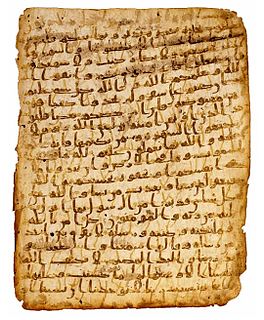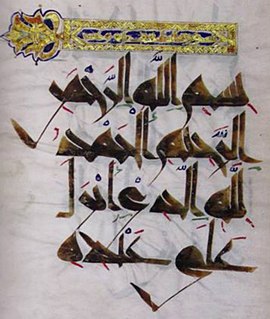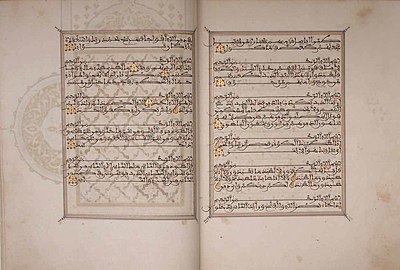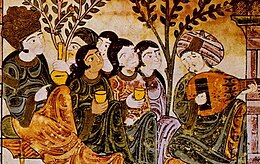
Arabic calligraphy is the artistic practice of handwriting and calligraphy based on the Arabic alphabet. It is known in Arabic as khatt, derived from the word 'line', 'design', or 'construction'. Kufic is the oldest form of the Arabic script.

Calligraphy is a visual art related to writing. It is the design and execution of lettering with a pen, ink brush, or other writing instrument. A contemporary calligraphic practice can be defined as "the art of giving form to signs in an expressive, harmonious, and skillful manner".

Nastaliq, also romanized as Nastaʿlīq, is one of the main calligraphic hands used to write the Perso-Arabic script in the Persian and Urdu languages, often used also for Ottoman Turkish poetry, rarely for Arabic. Nastaliq developed in Iran from naskh beginning in the 13th century and remains very widely used in Iran, Afghanistan and Pakistan and other countries for written poetry and as a form of art.

Islamic calligraphy is the artistic practice of handwriting and calligraphy, in the languages which use Arabic alphabet or the alphabets derived from it. It includes Arabic, Persian, Ottoman, and Urdu calligraphy. It is known in Arabic as khatt Arabi, which translates into Arabic line, design, or construction.

Naskh is a smaller, round script of Islamic calligraphy. Naskh is one of the first scripts of Islamic calligraphy to develop, commonly used in writing administrative documents and for transcribing books, including the Qur’an, because of its easy legibility.
Thuluth is a script variety of Islamic calligraphy. The straight angular forms of Kufic were replaced in the new script by curved and oblique lines. In Thuluth, one-third of each letter slopes, from which the name comes. An alternative theory to the meaning is that the smallest width of the letter is one third of the widest part. It is an elegant, cursive script, used in medieval times on mosque decorations. Various calligraphic styles evolved from Thuluth through slight changes of form.

Kufic script is a style of Arabic script that gained prominence early on as a preferred script for Quran transcription and architectural decoration, and it has since become a reference and an archetype for a number of other Arabic scripts. It developed from the Arabic alphabet in the city of Kufa, from which its name is derived. Kufic script is characterized by angular, rectilinear letterforms and its horizontal orientation. There are many different versions of Kufic script, such as square Kufic, floriated Kufic, knotted Kufic, and others.

Muhaqqaq is one of the main six types of calligraphic script in Arabic. The Arabic word muḥaqqaq (محقَّق) means "consummate" or "clear", and originally was used to denote any accomplished piece of calligraphy.
It is thought that the Arabic alphabet is a derivative of the Nabataean variation of the Aramaic alphabet, which descended from the Phoenician alphabet, which among others also gave rise to the Hebrew alphabet and the Greek alphabet, the latter one being in turn the base for the Latin and Cyrillic alphabets.

Maghrebiscript or Maghribi script refers to a loosely related family of Arabic scripts that developed in the Maghreb, al-Andalus (Iberia), and Biled as-Sudan. Maghrebi script is directly derived from the Kufic script, and is traditionally written with a pointed tip, producing a line of even thickness.

Hijazi script, also Hejazi, literally "relating to Hejaz", is the collective name for a number of early Arabic scripts that developed in the Hejaz region of the Arabian Peninsula, which includes the cities of Mecca and Medina. This type of script was already in use at the time of the emergence of Islam. A calligraphic Hijazi script is called a Ma'il script, these are found in a number of the earliest Qur'anic manuscripts. The two terms are often used interchangeably.

Sini is a calligraphic style used in China for the Arabic script. It can refer to any type of Chinese Arabic calligraphy, but is commonly used to refer to one with thick and tapered effects such as seen in Chinese calligraphy. It is used extensively in mosques in Eastern China and to a lesser extent in Gansu, Ningxia and Shaanxi.

Rasm is an Arabic writing script often used in the early centuries of Classical Arabic literature. Essentially it is the same as today's Arabic script except for the big difference that the Arabic diacritics are omitted. These diacritics include i'jam, consonant pointing, and tashkil, supplementary diacritics. The latter include the ḥarakāt (حَرَكَات) short vowel marks—singular: ḥarakah (حَرَكَة). As an example, in rasm, the five distinct letters ـبـ ـتـ ـثـ ـنـ ـيـ are indistinguishable because all the dots are omitted. Rasm is also known as Arabic skeleton script.
Persian calligraphy or Iranian calligraphy, is the calligraphy of the Persian language. It is one of the most revered arts throughout the history of Iran.

Ibn al-Bawwāb, also known as Ali ibn-Hilal, Abu'l-Hasan, and Ibn al-Sitri, was an Arabic calligrapher and illuminator who lived in Baghdad. He is the figure most associated with the adoption of round script to transcribe the Qur'an. He most likely died around 1022 CE in Baghdad.

The Blue Quran is an early Quranic manuscript written in Kufic script. The dating, location of origin, and patron of the Blue Quran are unknown and have been the subject of academic debate, though it is generally accepted that the manuscript was produced in the late 9th to mid 10th-century in either Kairouan, Tunisia or Cordoba in Umayyad Spain. The manuscript is among the most famous works of Islamic calligraphy, notable for its gold lettering on a rare indigo-colored parchment. Art historian Yasser Tabbaa wrote that the "evanescent effect" of the gold lettering on the blue parchment "appears to affirm the Mu'tazili belief in the created and mysterious nature of the Word of God."

In Muslim tradition the Quran is the final revelation from God, Islam's divine text, delivered to the Islamic prophet Muhammad through the angel Jibril (Gabriel). Muhammad's revelations were said to have been recorded orally and in writing, through Muhammad and his followers up until his death in 632 CE. These revelations were then compiled by first caliph Abu Bakr and codified during the reign of the third caliph Uthman so that the standard codex edition of the Quran or Muṣḥaf was completed around 650 CE, according to Muslim scholars. This has been critiqued by some western scholarship, suggesting the Quran was canonized at a later date, based on the dating of classical Islamic narratives, i.e. hadiths, which were written 150–200 years after the death of Muhammad, and partly because of the textual variations present in the Sana'a manuscript. With the discovery of earlier manuscripts which conform to the Uthmanic standard however, the revisionist view has fallen out of favor and been described as "untenable", with western scholarship generally supporting the classical Muslim view.

Old Arabic is the name for the pre-Islamic Arabic dialects and languages. The oldest attestation of the Arabic language goes back to Bayer, Jordan written in Ancient North Arabian script that is undifferentiated from other scripts of North Arabia. The Old Arabic languages and dialects were written in many scripts like Safaitic, Hismaic, Nabatean, Thamudic, Dadanitic, Cuneiform, Phoenician, and even Greek.

Kairouani style, or Kairouani Kufi style calligraphy, is one style of Islamic calligraphy.
Islamic manuscripts were produced in different ways depending on their use and time period. Parchment (vellum) was a common way to produce manuscripts. Manuscripts eventually transitioned to using paper in later centuries with the diffusion of paper making in the Islamic empire. When Muslims encountered paper in Central Asia, its use and production spread to Iran, Iraq, Syria, Egypt, and North Africa during the 8th century.



















